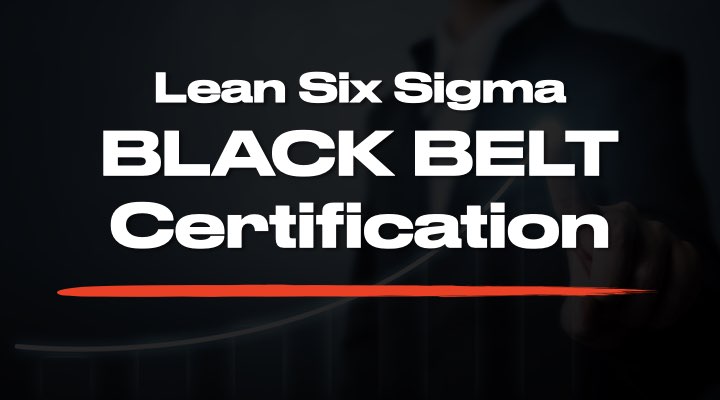
Certified Lean Six Sigma Black Belt
Level 4 Business Improvement

Qualification
Similar to the LSSGB level qualification, recipients of the 9 Skills Factory Lean Six Sigma Black Belt Qualification possess the knowledge, capability and tools to close performance gaps where they have a strong connection to a company's business plan.
They can be assigned complex process performance problems and effectively apply the more advanced tools of lean and six sigma methodologies to develop solutions that permanently fix those problems.
They have the potential to generate tremendous value for any organisation when working on process improvement projects that are value adding, important to line managers, and when allocated the time and resources to complete the work in a reasonable time frame.
Level of Professional Development
ADVANCED
Time Commitment
72 HOURS
Continued Professional Development (CPD) Scoring
256 CPD Points (Allocated @ 1 per lesson, 3 per quiz)
Attainment Criteria
TRAINING - Complete the full 26 week lean six sigma black belt training program which can be undertaken in various formats including:
(a) pro-coaching
(b) self paced through the 9 Skills Factory platform
APPLICATION - Lead at least three (3) improvement projects where solutions are not known, and competently apply the tools and processes from lean six sigma methodologies within the DMAIC framework. One (1) project credit is granted for candidates who are certified by George Lee Sye as LSS Green Belts.
ASSESSMENT - Successfully pass the Black Belt exam / Provide evidence of competency in utilising the DMAIC process improvement framework to generate quantifiable value.
PRE-REQUISITE - Candidates must be certified as a lean six sigma green belt to a standard consistent with the 9 Skills Factory LSSGB qualification as a minimum.
Competencies Demonstrated
Candidates holding this qualification, have successfully demonstrated the following core competencies:
- Manage People Relationships and Facilitate Teams
- Manage The Scope and Execution of a Solution Identification Project Using DMAIC
- Use Lean Techniques to Reduce Waste in Business Processes
- Analyse and Map a Value Stream
- Develop Detailed Activity Flowcharts
- Undertake Value Analysis of Processes in Terms of Customer Requirements
- Apply 5S Procedures to Optimise Workplace Flow
- Develop Quick Changeover Procedures by Applying SMED and QCO Tools
- Develop a Pull System for Operations and Processes
- Use Six Sigma Techniques to Analyse and Control Process Variation, and Improve Performance
- Collect and Organise Data
- Perform Computations
- Use Graphical Techniques, Perform Statistical Computations
- Apply Statistics to Operational Processes
- Undertake Root Cause Analysis
- Apply Cost Factors to Work Practices
- Determine and Improve Process Capability
- Identify Risk in a Project context and Apply Risk Management Processes
- Improve and Error Proof a Process with Failure Mode Effect Analysis
- Validate a Measurement System Using Measurement System Analysis Methods
- Validate Cause & Effect Relationships using Inferential Statistics
- Validate Cause & Effect Relationships by Analysing Correlation and Linear Relationships
- Design, Run and Analyse an Experiment using DOE
- Develop Improvement Plans using Basic Quality Function Deployment (QFD)

© 2019-2025 by George Lee Sye (Soarent Publishing ABN: 89699416331) - All Rights Reserved; no part of this publication and the publications provided in this product may be reproduced, stored in a retrieval system, or transmitted in any form or by any means, electronic, mechanical, photocopying, recording, or otherwise [except as required for the use of the purchaser of this product to complete the training course for which this is an accompaniment] without either the prior written permission of the copyright owner or a license permitting restricted copying issued by the copyright owner. This publication and the publications provided in this product may not be lent, resold, hired out or otherwise disposed of by way of trade in any form of binding or cover other than that in which it is published, without the prior consent of the copyright owner.
